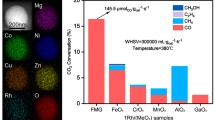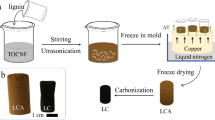Abstract
This research work demonstrates the in-situ carbonization technique to fabricate the symmetric supercapacitors using a two-dimensional vanadium carbide-based MAX phase derived from agricultural waste biomass "coconut shell" without using any stabilizer or binary-solvent systems. The electrochemical characterization of the MAX phase using three electrode setups along with insights from tools, such as XRD and SEM analysis. This unique structure contributed to a high specific capacity of 289 C g−1 at a scan rate of 10 mVs−1, accompanied by an impressive capacity retention of approximately 92% even after 2000 cycles, indicating exceptional volumetric stability. Furthermore, well-defined diffusion channels facilitated rapid charging and discharging processes, positioning V2AlC MAX as a promising contender among pseudocapacitive materials.











Similar content being viewed by others
Data availability
All required data can be found within the main manuscript file.
References
L. Nyholm, G. Nyström, A. Mihranyan, M. Strømme, Toward flexible polymer and paper-based energy storage devices. Adv. Mater. (2011). https://doi.org/10.1002/adma.201004134
S. Yeasmin, S. Talukdar, D. Mahanta, Paper based pencil drawn multilayer graphene-polyaniline nanofiber electrodes for all-solid-state symmetric supercapacitors with enhanced cyclic stabilities. Electrochim. Acta 389, 138660 (2021). https://doi.org/10.1016/j.electacta.2021.138660
P. Forouzandeh, V. Kumaravel, S.C. Pillai, Electrode materials for supercapacitors: a review of recent advances. Catalysts 10, 969 (2020). https://doi.org/10.3390/catal10090969
A. González, E. Goikolea, J.A. Barrena, R. Mysyk, Review on supercapacitors: Technologies and materials. Renew. Sustain. Energy Rev. 58, 1189–1206 (2016). https://doi.org/10.1016/j.rser.2015.12.249
Z.S. Iro, C. Subramani, S.S. Dash, A brief review on electrode materials for supercapacitor. Int. J. Electrochem. Sci. 11, 10628–10643 (2016). https://doi.org/10.20964/2016.12.50
T.B. Naveen, D. Durgalakshmi, A.K. Kunhiraman, S. Balakumar, R. Ajay Rakkesh, Recent advances in graphene-based micro-supercapacitors: Processes and applications. J. Mater. Res. 36, 4102–4119 (2021). https://doi.org/10.1557/s43578-021-00366-4
J. Fu, X. Jiang, W. Han, Z. Cao, Enhancing the cycling stability of transition-metal-oxide-based electrochemical electrode via pourbaix diagram engineering. Energy Storage Mater. 42, 252–258 (2021). https://doi.org/10.1016/j.ensm.2021.07.037
N. Angelidis, C.Y. Wei, P.E. Irving, The electrical resistance response of continuous carbon fibre composite laminates to mechanical strain. Compos Part A Appl. Sci. Manuf. 35, 1135–1147 (2004). https://doi.org/10.1016/j.compositesa.2004.03.020
C.M. Hamm, M. Dürrschnabel, L. Molina-Luna, R. Salikhov, D. Spoddig, M. Farle, U. Wiedwald, C.S. Birkel, Structural, magnetic and electrical transport properties of non-conventionally prepared MAX phases V2AlC and (V/Mn)2AlC. Mater. Chem. Front. 2, 483–490 (2018). https://doi.org/10.1039/C7QM00488E
W. Jeitschko, H. Nowotny, F. Benesovsky, Kohlenstoffhaltige ternare Verbindungen (H-Phase). Monatshefte For Chemie. 94, 672–676 (1963). https://doi.org/10.1007/BF00913068
M.W. Barsoum, The MN+1AXN phases: A new class of solids. Prog. Solid State Chem. 28, 201–281 (2000). https://doi.org/10.1016/S0079-6786(00)00006-6
M.W. Barsoum, T. El-Raghy, Synthesis and characterization of a remarkable ceramic: Ti3SiC2. J. Am. Ceram. Soc. 79, 1953–1956 (1996). https://doi.org/10.1111/j.1151-2916.1996.tb08018.x
Z. Sun, D. Music, R. Ahuja, S. Li, J.M. Schneider, Bonding and classification of nanolayered ternary carbides. Phys. Rev. B. 70, 092102 (2004). https://doi.org/10.1103/PhysRevB.70.092102
D.T. Cuskelly, E.H. Kisi, H.O. Sugo, MAX phase – Alumina composites via exchange reaction in the Mn+1AlCn systems (M=Ti, V, Cr, Nb, or Ta). J. Solid State Chem. 233, 150–157 (2016). https://doi.org/10.1016/j.jssc.2015.10.024
M. Radovic, M.W. Barsoum, MAX phases: Bridging the gap between metals and ceramics bulletin (n.d.) www.ceramics.org
V.J. Keast, S. Harris, D.K. Smith, Prediction of the stability of the MN+1AXN phases from first principles. Phys. Rev. B. 80, 214113 (2009). https://doi.org/10.1103/PhysRevB.80.214113
M.W. Barsoum, J. Golczewski, H.J. Seifert, F. Aldinger, Fabrication and electrical and thermal properties of Ti2InC, Hf2InC and (Ti, Hf)2InC. J. Alloys Compd. 340, 173–179 (2002). https://doi.org/10.1016/S0925-8388(02)00107-X
C. Brüsewitz, I. Knorr, H. Hofsäss, M.W. Barsoum, C.A. Volkert, Single crystal pillar microcompression tests of the MAX phases Ti2InC and Ti4AlN3. Scr. Mater. 69, 303–306 (2013). https://doi.org/10.1016/j.scriptamat.2013.05.002
R. Venkatkarthick, N. Rodthongkum, X. Zhang, S. Wang, P. Pattananuwat, Y. Zhao, J. Qin, Vanadium-based oxide on two-dimensional vanadium carbide MXene (V2Ox@V2CTx) as cathode for rechargeable aqueous zinc ion batteries. ACS Appl. Energy Mater. 3, 4677–4689 (2020). https://doi.org/10.1021/acsaem.0c00309
O. Hossein-Zadeh, H. Mirzaee, M. Mohammadian-Semnani, Razavi, Microstructure investigation of V2AlC MAX phase synthesized through spark plasma sintering using two various sources V and V2O5 as the starting materials. Ceram. Int. 45, 23902–23916 (2019). https://doi.org/10.1016/j.ceramint.2019.07.236
J. Gonzalez-Julian, Processing of MAX phases: From synthesis to applications. J. Am. Ceram. Soc. 104, 659–690 (2021). https://doi.org/10.1111/jace.17544
M. Safarpour, S. Hosseinpour, M. Haddad Irani-nezhad, Y. Orooji, A. Khataee, Fabrication of Ti2SnC-MAX Phase Blended PES Membranes with Improved Hydrophilicity and Antifouling Properties for Oil/Water Separation. Molecules. 27, 8914 (2022). https://doi.org/10.3390/molecules27248914
M. Liu, J. Niu, Z. Zhang, M. Dou, F. Wang, Potassium compound-assistant synthesis of multi-heteroatom doped ultrathin porous carbon nanosheets for high performance supercapacitors. Nano Energy. 51, 366–372 (2018). https://doi.org/10.1016/j.nanoen.2018.06.037
Y. Ge, X. Xie, J. Roscher, R. Holze, Q. Qu, How to measure and report the capacity of electrochemical double layers, supercapacitors, and their electrode materials. J. Solid State Electrochem. 24, 3215–3230 (2020). https://doi.org/10.1007/s10008-020-04804-x
S. Di, L. Gong, B. Zhou, Precipitated synthesis of Al2O3-ZnO nanorod for high-performance symmetrical supercapacitors. Mater. Chem. Phys. 253, 123289 (2020). https://doi.org/10.1016/j.matchemphys.2020.123289
M. Farahmandjou, A. Khodadadi, M. Yaghoubi, Low concentration iron-doped alumina (Fe/Al2O3) nanoparticles using co-precipitation method. J. Supercond. Nov. Magn. 33, 3425–3432 (2020). https://doi.org/10.1007/s10948-020-05569-0
B. Scheibe, V. Kupka, B. Peplińska, M. Jarek, K. Tadyszak, The Influence of Oxygen Concentration during MAX Phases (Ti3AlC2) Preparation on the α-Al2O3 Microparticles Content and Specific Surface Area of Multilayered MXenes (Ti3C2Tx). Materials. 12, 353 (2019). https://doi.org/10.3390/ma12030353
M. Baben, L. Shang, J. Emmerlich, J.M. Schneider, Oxygen incorporation in M2AlC (M=Ti, V, Cr). Acta Mater 60, 4810–4818 (2012). https://doi.org/10.1016/j.actamat.2012.05.011
R. Thakur, A. VahidMohammadi, J. Moncada, W.R. Adams, M. Chi, B. Tatarchuk, M. Beidaghi, C.A. Carrero, Insights into the thermal and chemical stability of multilayered V2CTx MXene. Nanoscale. 11, 10716–10726 (2019). https://doi.org/10.1039/C9NR03020D
O.D. Leaffer, S. Gupta, M.W. Barsoum, J.E. Spanier, On Raman scattering from selected M2AC compounds. J. Mater. Res. 22, 2651–2654 (2007). https://doi.org/10.1557/JMR.2007.0376
L. Shi, T. Ouisse, E. Sarigiannidou, O. Chaix-Pluchery, H. Roussel, D. Chaussende, B. Hackens, Synthesis of single crystals of V2AlC phase by high-temperature solution growth and slow cooling technique. Acta Mater. 83, 304–309 (2015). https://doi.org/10.1016/j.actamat.2014.10.018
M. Hu, Z. Li, T. Hu, S. Zhu, C. Zhang, X. Wang, High-capacitance mechanism for Ti3C2Tx MXene by in Situ electrochemical raman spectroscopy investigation. ACS Nano. 10, 11344–11350 (2016). https://doi.org/10.1021/acsnano.6b06597
Y. Zhang, Designed synthesis and supercapacitor electrode of V2O3@C core-shell structured nanorods with excellent pseudocapacitance in Na2SO4 neutral electrolyte. Chemistryselect. 3, 1577–1584 (2018). https://doi.org/10.1002/slct.201702705
J. Wang, J. Polleux, J. Lim, B. Dunn, Pseudocapacitive contributions to electrochemical energy storage in TiO2 (Anatase) nanoparticles. J. Phys. Chem. C. 111, 14925–14931 (2007). https://doi.org/10.1021/jp074464w
H. Sun, L. Mei, J. Liang, Z. Zhao, C. Lee, H. Fei, M. Ding, J. Lau, M. Li, C. Wang, X. Xu, G. Hao, B. Papandrea, I. Shakir, B. Dunn, Y. Huang, X. Duan, Three-dimensional holey-graphene/niobia composite architectures for ultrahigh-rate energy storage. Science (1979) 356, 599–604 (2017). https://doi.org/10.1126/science.aam5852
R. Kumar, M. Bag, Quantifying capacitive and diffusion-controlled charge storage from 3D Bulk to 2D layered halide perovskite-based porous electrodes for efficient supercapacitor applications. J. Phys. Chem. C. 125, 16946–16954 (2021). https://doi.org/10.1021/acs.jpcc.1c05493
T. Li, Z. Liu, L. Zhu, F. Dai, L. Hu, L. Zhang, Z. Wen, Y. Wu, Cr2O3 nanoparticles: a fascinating electrode material combining both surface-controlled and diffusion-limited redox reactions for aqueous supercapacitors. J. Mater. Sci. 53, 16458–16465 (2018). https://doi.org/10.1007/s10853-018-2743-0
H. Shao, Z. Lin, K. Xu, P.-L. Taberna, P. Simon, Electrochemical study of pseudocapacitive behavior of Ti3C2Tx MXene material in aqueous electrolytes. Energy Storage Mater. 18, 456–461 (2019). https://doi.org/10.1016/j.ensm.2018.12.017
X. Pan, Y. Zhao, G. Ren, Z. Fan, Highly conductive VO2 treated with hydrogen for supercapacitors. Chem. Commun 49, 3943 (2013). https://doi.org/10.1039/c3cc00044c
C. Li, Z. Dai, W. Liu, P. Kantichaimongkol, P. Yu, P. Pattananuwat, J. Qin, X. Zhang, A self-sacrifice template strategy to synthesize Co-LDH/MXene for lithium-ion batteries. Chem. Commun. 57, 11378–11381 (2021). https://doi.org/10.1039/D1CC04492C
Q. Abbas, L. Wen, M.S. Javed, A. Ahmad, M.S. Nazir, M.A. Assiri, M. Imran, P. Bocchetta, Binder-free porous 3D-ZnO hexagonal-cubes for electrochemical energy storage applications. Materials. 15, 2250 (2022). https://doi.org/10.3390/ma15062250
Z. Pan, F. Cao, X. Hu, X. Ji, A facile method for synthesizing CuS decorated Ti3C2 MXene with enhanced performance for asymmetric supercapacitors. J. Mater. Chem. A. 7, 8984–8992 (2019). https://doi.org/10.1039/c9ta00085b
J. Sun, X. Du, R. Wu, Y. Zhang, C. Xu, H. Chen, Bundlelike CuCo2O4 microstructures assembled with ultrathin nanosheets as battery-type electrode materials for high-performance hybrid supercapacitors. ACS Appl. Energy Mater. 3, 8026–8037 (2020). https://doi.org/10.1021/acsaem.0c01458
A. Numan, P. Ramesh Kumar, M. Khalid, S. Ramesh, K. Ramesh, E.M. Shamsudin, Y. Zhan, P. Jagadesh, Facile sonochemical synthesis of 2D porous Co3O4 nanoflake for supercapattery. J. Alloys Comp. 819, 153019 (2020). https://doi.org/10.1016/j.jallcom.2019.153019
R. Kumar, P. Rai, A. Sharma, 3D urchin-shaped Ni3(VO4)2 hollow nanospheres for high-performance asymmetric supercapacitor applications, J. Mater. Chem. A. 9822–9831 (2016). https://doi.org/10.1039/c6ta03519a
Y. Teng, Y. Li, D. Yu, Y. Meng, Y. Wu, X. Zhao, X. Liu, The microwave-assisted hydrothermal synthesis of CoV2O6 and Co3V2O8 with morphology tuning by pH adjustments for supercapacitor applications. ChemistrySelect 4, 956–962 (2019). https://doi.org/10.1002/slct.201803141
T. Selvam, D. Dhinasekaran, B. Subramanian, A.R. Rajendran, Layered structures of enriched V5+ states of vanadium oxide as a hybrid cathode material for long-cyclable aqueous zinc-ion batteries. ACS Appl. Mater. Interfaces. 15, 30350–30359 (2023). https://doi.org/10.1021/acsami.3c05835
Acknowledgements
The authors express gratitude to the SRM Institute of Science and Technology for awarding the SRM fellowship that facilitated the execution of this research. Additionally, recognition is extended to the Department of Science and Technology (DST) for the funding provided under the sanction DST-SERB file no.: EEQ/2023/000314. Furthermore, appreciation is given to the SRM-SCIF, NRC, and PNCF for their support in providing the Instrumentation Facility.
Funding
Not applicable.
Author information
Authors and Affiliations
Contributions
T.B. Naveen: Conceptualization, Investigation, Methodology, Writing – Original draft, D. Durgalakshmi: Conceptualization, Investigation, Methodology, S. Balakumar: Validation, Review and R. Ajay Rakkesh: Investigation, Supervision, Review & editing, Conceptualization.
Corresponding authors
Ethics declarations
Ethical approval
Not applicable.
Competing interests
The authors declare that they have no conflict of interest.
Rights and permissions
Springer Nature or its licensor (e.g. a society or other partner) holds exclusive rights to this article under a publishing agreement with the author(s) or other rightsholder(s); author self-archiving of the accepted manuscript version of this article is solely governed by the terms of such publishing agreement and applicable law.
About this article
Cite this article
Naveen, T.B., Durgalakshmi, D., Balakumar, S. et al. Biomass-derived vanadium-based MAX phase nanostructures as stabilizer-free materials for symmetric supercapacitors. emergent mater. (2024). https://doi.org/10.1007/s42247-024-00741-x
Received:
Accepted:
Published:
DOI: https://doi.org/10.1007/s42247-024-00741-x




